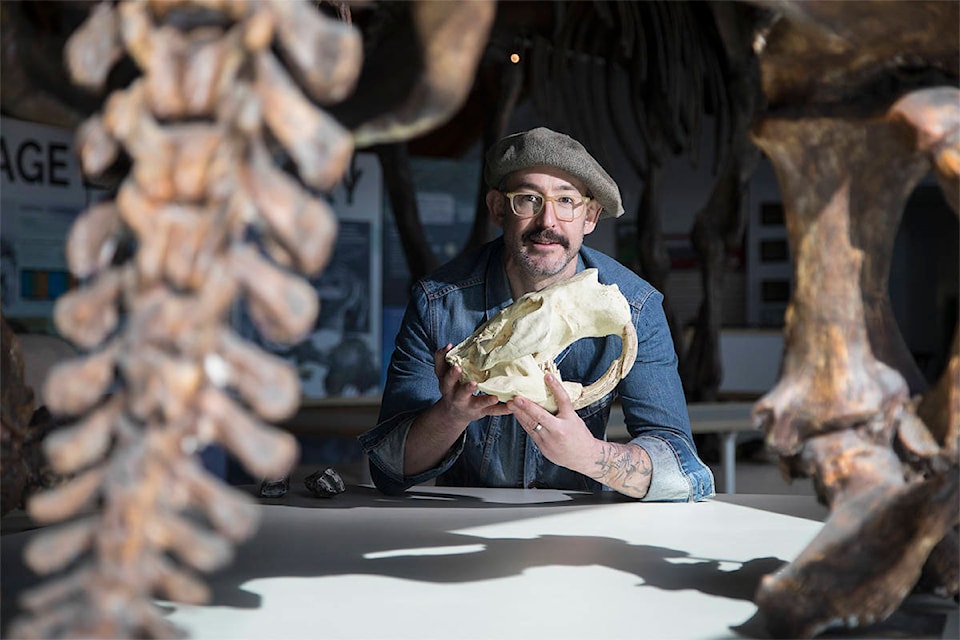You’d be forgiven for assuming, at first glance, that the skull of the now-extinct giant beaver was one belonging to a predator of some sort.
Larger than a basketball and with two, 20-centimetre teeth descending from the top jaw, the skull looks like it could belong to a creature that would have inflicted serious damage on its ice-age peers, asserting its dominance with its intimidating fangs.
But luckily for its contemporaries, the giant beaver wasn’t interested in any of that — the 100-kilogram, up-to-two-metre-long rodent dined on pond weeds and pond weeds only, a new study has confirmed.
“I think anytime anyone sees our giant beaver skull, they’re like, ‘Wow, it must have been a sabre-tooth cat and eating people,’” Yukon government palaeontologist Grant Zazula told the News in an interview May 13.
“No, just pond weeds. It’s almost like, kind of anti-climatic, you know? You have this animal that’s seven feet tall that just eats little pond weeds and you want it to be more dramatic than that, but it’s not.”
Zazula was a co-author of a paper published in Nature earlier this month detailing the giant beaver’s diet based on an carbon and nitrogen isotope analysis of fossils from 11 different creatures, some of them collected from the Old Crow area. Led by researcher Tessa Plint, and with the assistance of University of Western Ontario professor Fred Longstaffe and Zazula, the study found that the giant beaver did not, like its smaller cousin that still exists today, eat tree parts at all.
Instead, the giant beaver, which ranged across North America from Alaska and the Yukon down to the Great Lakes and Florida, subsisted predominantly on submerged aquatic macrophytes (basically, plants that grow underwater), a dietary choice that likely factored heavily into its extinction.
It’s the first study of its kind looking into the giant beaver’s diet on such a scale; there was previously one study done on a single fossil.
The giant beaver is believed to have migrated north from the United States about 100,000 years ago, essentially pond-hopping its way into Canada and Alaska via the giant lakes and ponds created by the meltwater from the giant glacier that covered most of Canada
The species made it as far north as Old Crow, where Zazula said it’s “fairly common” to find fossils eroding out of riverbanks; the Vuntut Gwitchin have been leading scientists to the fossils for at least a hundred years.
But while the giant beaver thrived in what was then the wet environment, it ran into a big problem about 25,000 years later — the climate began to shift to a much drier, warmer one.
With that shift came the disappearance of the wetlands in the North that the giant beaver relied so heavily on. While it continued to live on in the areas south of the Great Lakes and in Florida, it was the beginning of the end for the species.
“What’s fascinating to me about that is that it provides a really cool analogue about what’s happening today in the North, because we see animals moving north, north, north all the time now because of warming conditions,” Zazula said.
”…That happened 100,000 years ago as well, these animals saw these environments moving northward and they followed the environment and ended up in a place where they probably shouldn’t be, like the Yukon, because they’re animals that evolved in more southern conditions.”
What’s particularly interesting, Zazula added, is that the little beavers we’re familiar with today were also around with the giant beaver roamed North America, and both were likely living in similar types of swampy, forest-type environments.
The little beaver, though, had at least one advantage — its diet also included (and still includes) things like tree bark, twigs and leaves, meaning that it was still able to keep itself fed even when the wetlands began to dry.
As well, the little beaver is famously known for its ability to build dams, stopping streams or rivers to create ponds as needed. It’s unclear if the giant beaver had the same capability of engineering its environment; even though it had massive front teeth, they don’t have the same sort of chiseled ends that allow for the little beaver to efficiently chomp through tree trunks.
But that, in turn, leads to another question — if they weren’t using them to cut down or trees, what were giant beavers doing with their massive teeth?
“They’re rodents and rodents have ever-growing incisors, they keep growing throughout their lifetime, so they had to have been doing something with their giant incisors to wear them down or else they would probably die,” Zazula said.
He said he was hopeful that someone else would pick up the research from there.
Contact Jackie Hong at jackie.hong@yukon-news.com
